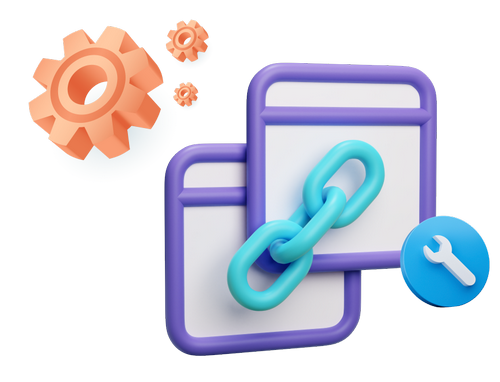A backlink audit is your starting point when you embark on a journey to grow your backlink profile. It helps you pinpoint and decline malicious backlinks that endanger your site’s ranking and uncover solid backlink opportunities. In short, any link building strategy starts with a robust backlink audit.
Keep reading this guide to learn how to conduct a backlink audit in 7 easy steps.
What is a Backlink Audit?
A backlink audit is a multifaceted analysis of your website’s backlink profile, including both inbound and outbound links. The purpose of a backlink audit is to evaluate the quality of your link profile, identify any spammy or low-quality links, and discover new link opportunities.
During a backlink audit, you will examine various metrics that contribute to the quality and relevance of each link, such as the domain authority (DA/DR) of the linking site, anchor texts, and the context of the link. You’ll also compare your site against competitors to understand how many links it takes to beat the rival in the SERPs.
Given that, backlink audits are an essential part of any link building strategy that helps you make informed decisions about which links to keep, disavow, or pursue.
But how often should you perform backlink audits?
We asked an expert to share his insights:
«I think that the frequency depends on the type of link profile your site has.
Some of my clients do it every month, including disavowing bad links. That’s because they attracted bad links to begin with, and this resulted in loss of rankings. Bad links keep coming back and this requires regular links maintenance and auditing.
Other websites can do it every 3−4 months if they have an healthy link profile. Sometimes clients hire PR agencies and they generate new links to the website which need to be reported and audited for performance. Or maybe they hire a link building specialist to help with scaling their efforts. Maybe they bought links that seem a bit shady and need some checks.
If your site is not doing any of those activities, there is probably no need to do any regular audit." - Luca Tagliaferro, SEO expert and consultant. [website]
Why is a Backlink Audit Important?
Let’s explore four more benefits of regular backlink audits.
Reason #1: You identify negative SEO attacks
Negative SEO is a malicious attack on your site’s backlink profile to drop its rankings or even get it removed from the search engine page results.
When auditing your backlink profile, you can spot links that look unnatural or out of place.
For instance, too many links with spammy-looking anchor text, from foreign countries, URLs with no content, low-quality sitewide links, etc., are the signs of a negative SEO attack. Also, spikes in the number of backlinks can indicate a malicious link building campaign (see the image below).
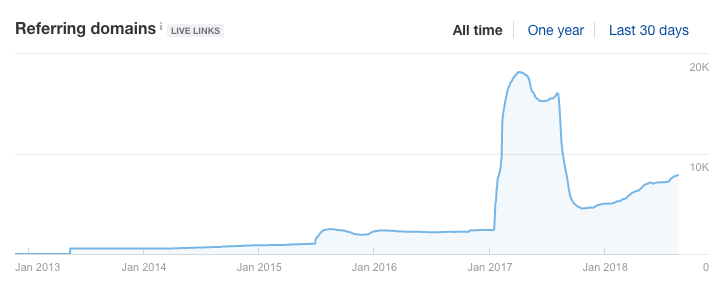
A negative SEO attack.
Reason #2: You find qualified link opportunities
Apart from identifying toxic links, a backlink audit helps you dig out potential opportunities from competitors' backlinks. When you find high-quality links from trusted sources, you may use various outreach tactics to get your content featured there.
For example, SEO pros and link building agencies analyze what types of pages/content tend to receive the most links and use the backlink data for future link building campaigns.
Reason #3: You improve organic performance
A thorough backlink audit can allow a website to «breathe,» enabling you to remove toxic links and chase only good backlink prospects. This, in turn, will help you increase organic rankings and website authority, as well as drive more organic traffic.
In March, we at Digital Olympus strategically built only 8 links to the client’s page, resulting in a remarkable increase of over 400 organic visitors compared to February. We placed the links not only on sites that are highly relevant to the client’s niche but also on pages relevant to the linked page.

It took one month to see an increase in organic traffic thanks to link building.
If you were curious how fast you can see the result — from 1 to 3 months, depending on the niche and link building strategy itself.
Reason #4: You monitor your link building efforts
Finally, backlink audits are also a great way to keep tabs on your link building efforts. You can track how many new links you’ve gained/lost and how their quality has been developing with time. This can help you identify trends and dips in your link building profile, track progress in terms of link quality and quantity, and adjust your strategy accordingly.
Ready for the nitty-gritty of carrying out backlink audits? Keep reading.
How to Perform a Backlink Audit Step-by-Step
Let’s take a closer look at how to perform a backlink audit in 7 easy steps — with screenshots and examples. Also, you’ll need a backlink audit tool — Ahrefs, Semrush, Majestic, Moz, or any other.
Step #1: Compare your backlink profile to the competition
To start off, you need to collect data on your competitors' link profiles. This will help you benchmark your site against the competition and get a high-level understanding of the number of links you’ve got to acquire.
Open up Ahrefs and navigate to More → Batch Analysis. Enter your and competing domains and get a quick overview of:
- Referring domains
- Organic traffic
- DR (domain rating)
- Page authority
- The number of TLDs (top-level domains like .gov, .edu)
- Dofollow/nofollow ratio
- Types of links
Here’s an example of a backlink analysis report generated in Ahrefs:
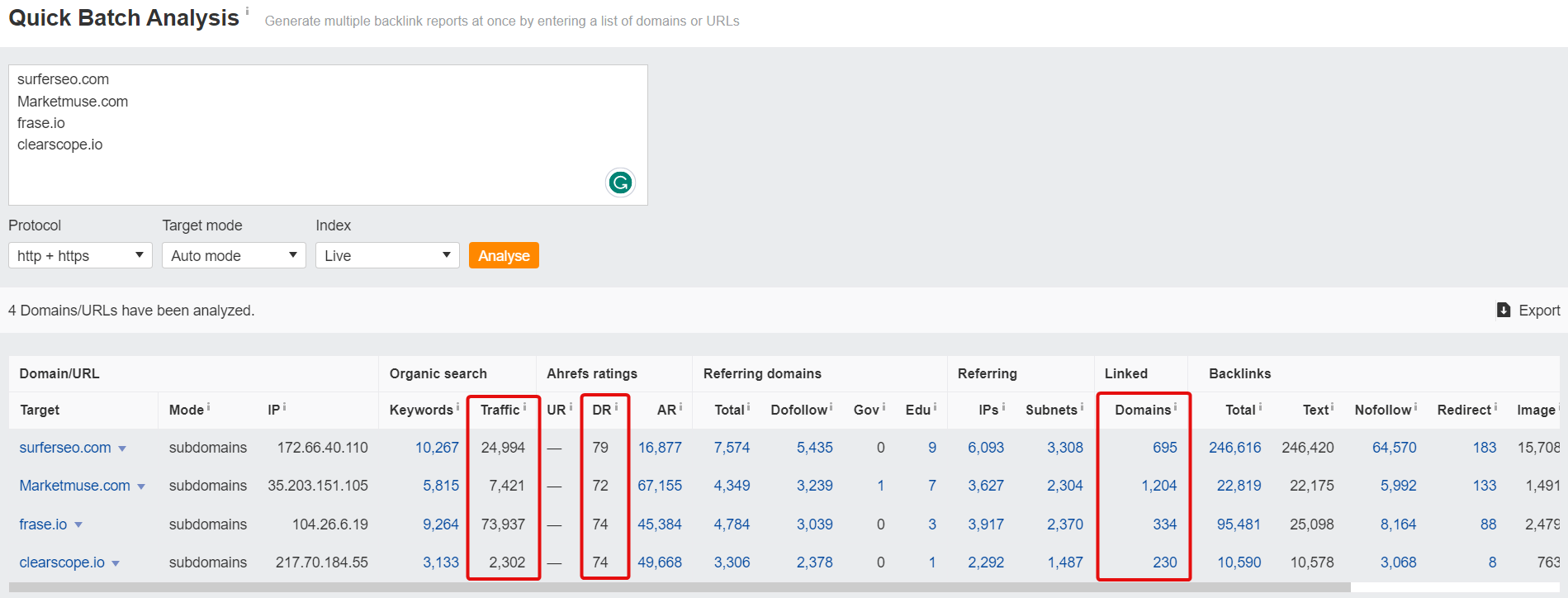
Batch domain analysis.
What you can learn is that organic traffic and DR don’t always correlate with the number of backlinks. Marketmuse has twice more referring domains as Surfer, but Surfer’s DR is higher, and it gets more search traffic.
Does it mean backlinks don’t work?
Not really. Our guess is that Marketmuse has a weak backlink profile compared to Surfer. Let’s prove it.
Step #2: Evaluate CTLDs distribution
Next up, the CTLDs distribution can also provide some helpful insights. In other words, you need to figure out where your backlinks are coming from — what countries or regions. A diverse link profile with links from different countries can signal trustworthiness and credibility in Google’s eyes.
Also, keep an eye out for spammy backlinks from certain countries like India, Pakistan, etc. It’s not always the case, but if you target the US market, you don’t want to receive tons of bad links from irrelevant countries and get Google to pour more traffic from them.
On the contrary, generic TLDs like «.com» and «.net» tend to be less spammy and of higher quality.
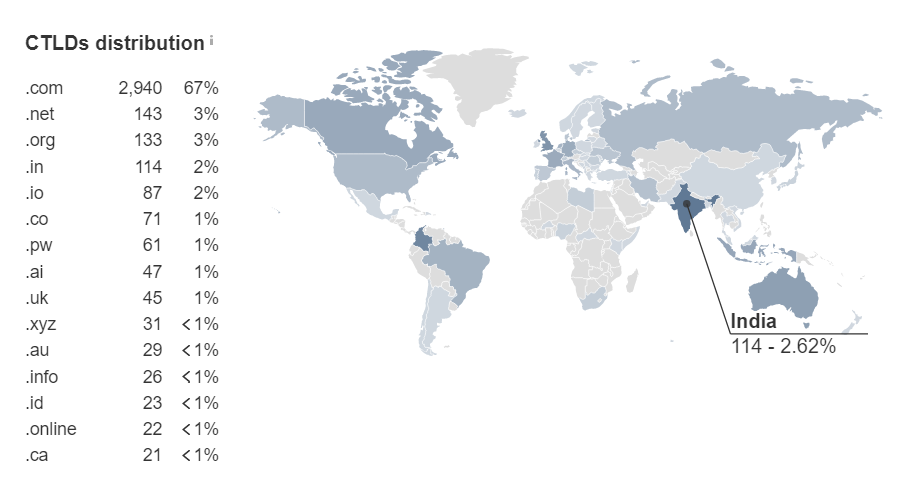
CTLDs distribution.
This is Marketmuse’s backlink profile, with most referring domains coming from .com and .net but from India.
Step #3: Evaluate link quality and relevancy
Now, we dig even deeper and assess the quality of your backlink profile. Some links may look suspicious and might need manual verification or even removal. There are several things to look for:
- The link quality — heavily influences a site’s DR, rankings, and organic traffic, as a result.
- The link relevance — a crucial factor Google algorithms keep tabs on.
- Anchor text — contextual, not stuffed with keywords, not spammy-looking.
So let’s pretend that Marketmuse is our site and analyze its backlinks closely.
Navigate to Site Explorer → Referring domains and set filters by DR 0−10 and by traffic 0 to 1,000. You’ll get the report that identifies potentially harmful backlinks — a whopping 1,923 for Marketmuse.
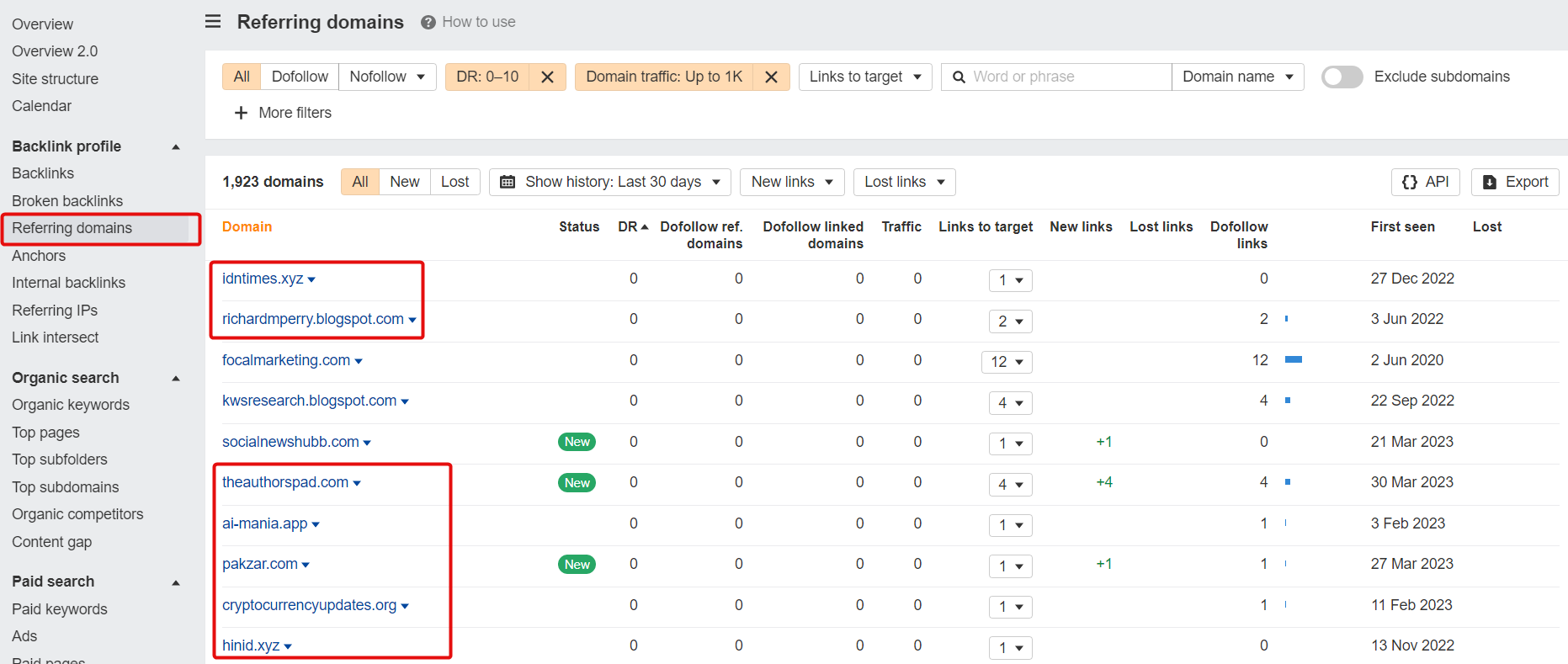
Find suspicious referring domains.
All these referring domains look «fishy.» To analyze the context of the pointing link, click on the caret. Spotted! This is a 100% spammy link from the .xyz domain.

Analyze the context and relevance of a link.
?Tip: You don’t need to check all the bad backlinks manually. Export the list of backlinks, open Google Search Console, and find the Google Disavow tool. Upload the disavow file and remove «fishy» links.
Step #4: Check your nofollow to dofollow ratio
Nofollow links don’t pass any link juice to your website and thus can’t be used for ranking. They come with an HTML attribute rel="nofollow." Contrary, dofollow links carry link equity and are the ones you should pay attention to.
As a rule of thumb, your nofollow to dofollow ratio should be balanced, with dofollow links outnumbering (but not solely consisting of them). The ratio of 3:1 is a golden middle.
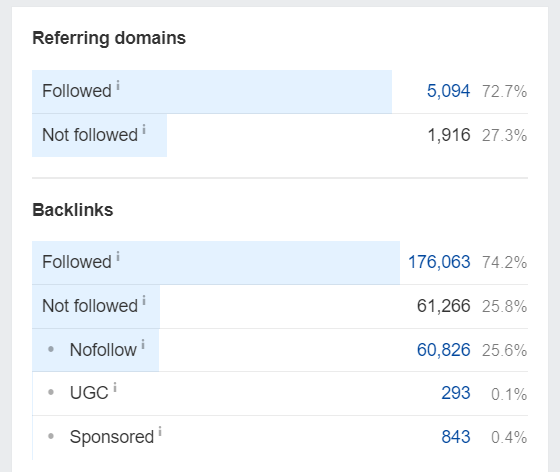
Dofollow/nofollow link ratio.
Head over to the Overview 2.0 report to access this chart.
Note, however, that this ratio isn’t something that should take your entire focus.
«With backlinks the most important thing is the authority of the site linking to you and (ideally) it is highly relevant to your niche. You could get a NoFollow from Forbes or Wikipedia and I think that would be a great thing, a DoFollow would be better but either way the point is the quality of the site linking to you. Don’t worry so much, focus on creating a quality, non-spammy backlink profile—naturally you will get both.» — Ben Goodey, Founder at How the F*ck (check Ben’s SEO case studies based on interviews with experts from top companies).
Step #5: Fix broken links
Broken links are simply links that don’t work — the page has been moved, deleted, or the URL isn’t correct anymore. If those links have quality external links, it’s a huge loss for your site. Referring links are supposed to pass link juice, but if they target a broken page, your site doesn’t get any link equity.
A quick win is to look at linking sites and contact their webmasters to replace a link.
Open up the Best by Links report. Filter for «404 Not Found» and sort by the number of referring domains.
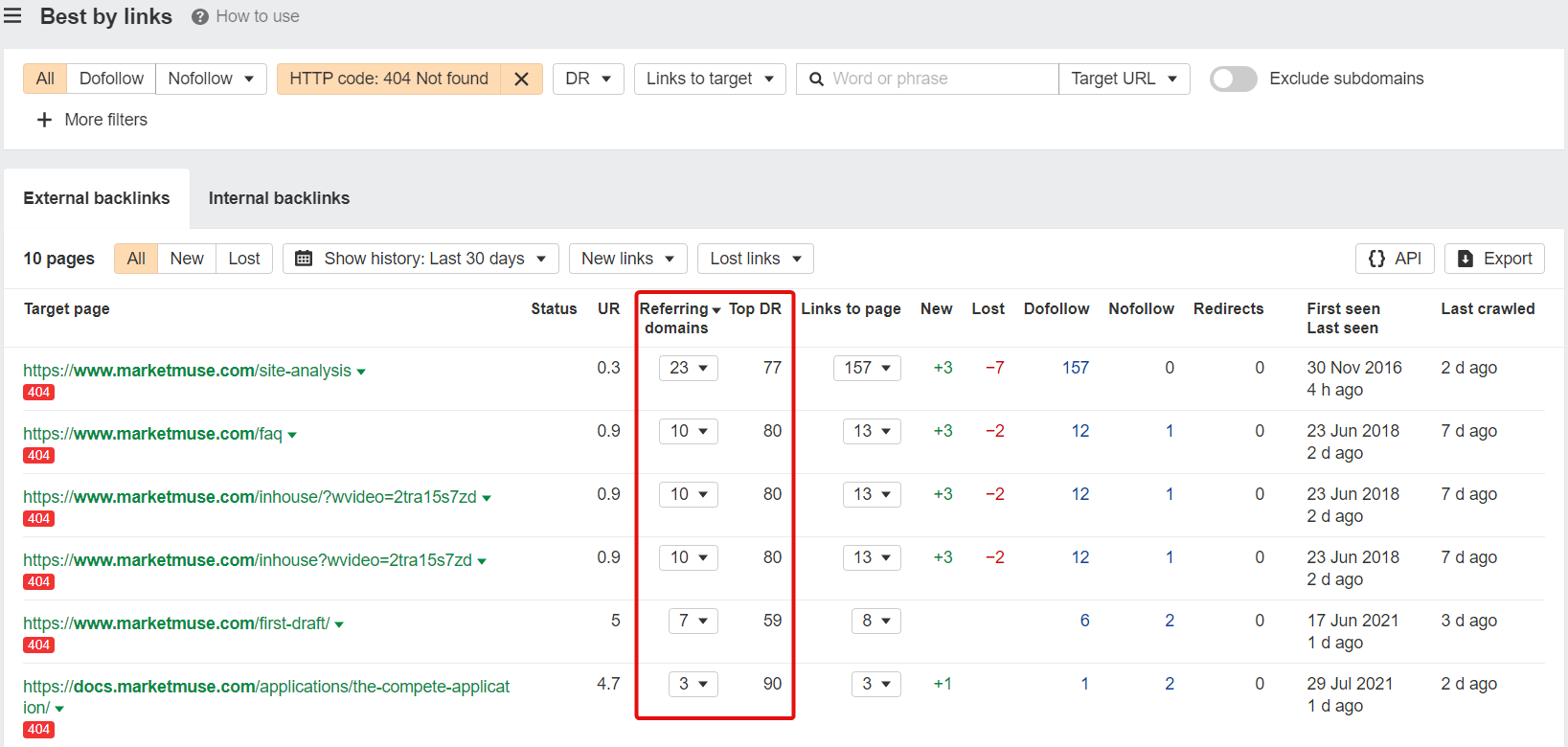
How to find broken links with Ahrefs.
The Top DR column suggests you’re missing out on high-quality backlinks from DR80+ sites.
Step #6: Find underperforming web pages with lots of links
A link audit also helps to identify low-hanging fruits with lots of external links. It means you can find pages that receive a lot of backlinks but hardly get any traffic or conversions. It could be due to outdated information, lack of content, or a broken design.
Head over to the Top Pages report and seek URLs with low traffic but a considerably high number of backlinks.
For instance, the blog post in red ranks for 11 positions and has 36 linking domains. With small content changes or improved internal linking, you can push this page into the top 10.

Discover underperforming pages with high potential.
Remember, that poorly done internal linking can absolutely be the reason why your website is not getting enough traction from backlinks:
«Improper internal linking like linking to irrelevant or the wrong content or creating too many internal links that point to the same page can limit the link equity gained from backlinks, causing your page and site to not gain as much authority and ranking in SERPS.
Internal linking plays a crucial role in how search engines evaluate the relevance and importance of your page or website. In addition to lower search engine rankings, your users will have a poor experience, likely causing an increase in bounce rate. So, it’s important to have a well-structured internal linking strategy that ensures that your website’s authority is distributed effectively throughout your site, allowing all pages to benefit from the link equity coming from backlinks." - Kimberly Anderson-Mutch, seasoned SEO, content marketer, Director of Digital Content at Mutch Creative.
Step #7: Examine your most linked-to pages to identify trends
Your site’s most-linked pages can reveal content topics your target audience finds valuable. This will inform your content marketing and digital PR strategies and gear toward shared and linked content.
Navigate to the Best by Links report to analyze the most linked pages and find commonalities. Do so with your and competitors' websites.
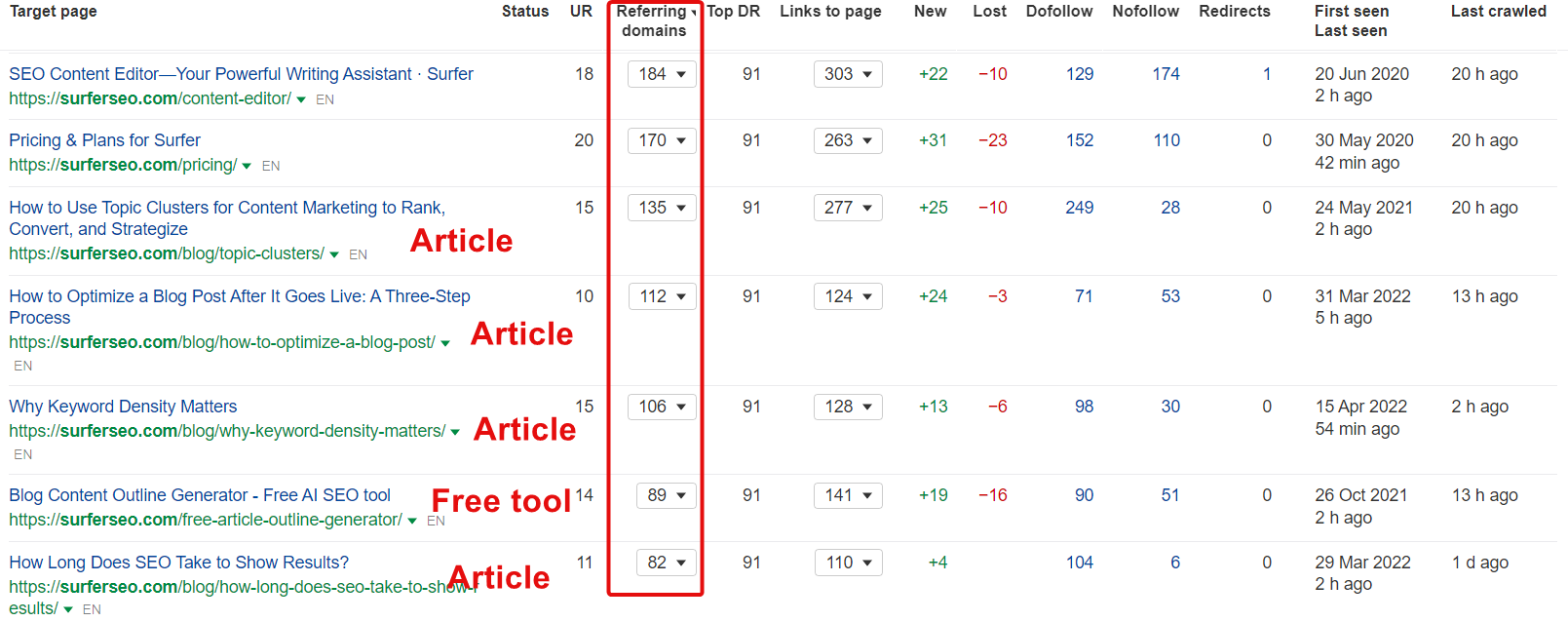
Learn which types of content earn inbound links.
In the screenshot, you see that articles acquire most of the links. But… Everybody writes articles.
With that, your next step is to scrutinize the most linked-to articles and pinpoint patterns and trends. Also, delve further and analyze how competitors distribute their content.
Now Over to You
Overall, a comprehensive link audit is a fundamental part of your SEO strategy. It allows marketers to find opportunities for growth through content optimization and internal linking and locate toxic backlinks to avoid Google penalties.
Need a helping hand with link building? Contact our Senior Link Building Specialist at Digital Olympus. We’ll discuss your SEO objectives and devise a customized link building strategy that meets your specific criteria.
Read more on advanced link building:





